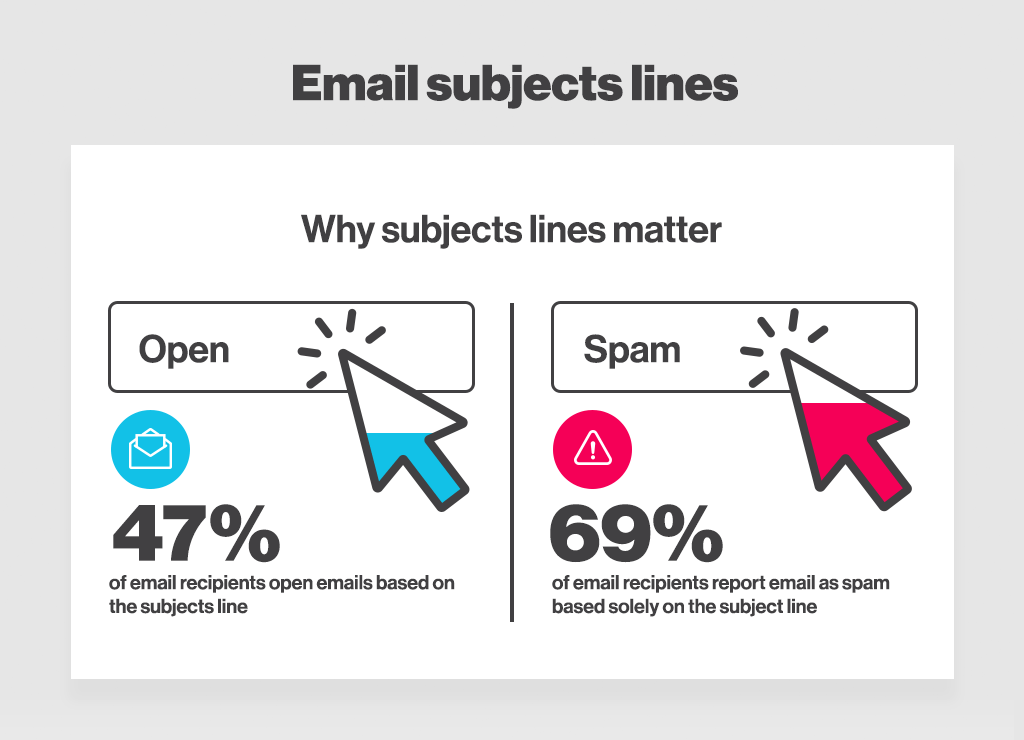Email marketing is essential to any business’ marketing strategy. However, making your email stand out from other messages in your recipients’ inboxes is not always easy to do. One of the most important factors in making sure your email or newsletter gets read is the subject line. After all, 47% of recipients decide to open an email based on the subject line alone.
Plus, a poorly written email subject line can cause your message to be deleted without a second thought. In fact, 69% of recipients say they report an email as spam simply after reading the subject line.
In this blog post, we’ll discuss proven strategies for writing effective email subject lines that will help you maximize your open rate.

9 Proven Strategies for Writing Effective Email Subject Lines:
- Keep it short and sweet
- Be clear and specific
- Use action words
- Personalize
- Use numbers and emojis
- Avoid spam triggers
- Test different subject lines
- Use a sense of Curiosity
- Use Urgency
Keep it short and sweet
Your subject line should be as short as possible while still conveying the main message of your email. A good rule of thumb is to keep subject lines under 50 characters. According to a Marketo study, the ideal subject line with the highest open rate is 7 words and a maximum of 41 characters.
Be clear and specific
The subject line should clearly and specifically describe what your email is about. Avoid using vague or misleading language or you risk damaging your company’s reputation and diminishing your subscribers’ trust.
Here are some examples of emails that should or should not be followed, as they can be misleading and considered “spam” or phishing:
| Don’ts | Do’s |
|---|---|
| You’re a winner! | You’re a winner! Claim your prize now |
| Urgent: open immediately for a surprise | Open for a [specific surprise] surprise |
| Check out our new products! | New products alert: [list of specific products] |
| Only for a limited time | Limited time offer: [specific deadline] |
With more context or specific information in the subject line, recipients will better understand the subject of your email and be more likely to open it. It’s important to give your subscribers the right information so they can make an informed decision about whether or not to open your message.
Use action words
To encourage the recipient to take a specific action, it is effective to use action verbs and words in the subject line of an email message: with verbs like “buy”, “sign up”, “download” or “act now”, the message seems more important and increases the likelihood that your recipient will open the email.
Here are some examples of subject lines using a word or action verb:
- Join our webinar
- Download your free guide
- Save your spot
- Upgrade your plan now
- Start your trial today
- Claim your discount
- Shop our clearance sale
- Sign up for our newsletter
- RSVP for our event
- Submit your application
Personalize
Personalizing the subject line of an email message increases its relevance to the recipient. Personalization can take many forms, but most often it involves addressing the recipient by name or referring to a previous interaction or purchase.
It’s important to keep in mind that while personalizing a subject line can increase the open rate of your email, it must be used in a relevant and appropriate manner. You also need to be careful to comply with data privacy laws and regulations.
Here are some examples of personalized subject lines:
- Welcome back [Name], we missed you!
- Thanks for your purchase [Name]
- Happy birthday [Name], enjoy your special offer!
- Your personalized recommendation [Name]
- Don’t miss out on your exclusive offer [Name]
- Invitation to our VIP event [Name]
- Welcome to our loyalty program [Name]
Use numbers and emojis
Using numbers and emojis can make a subject line more eye-catching and make your email stand out in an inbox.
Use numbers to convey specific information, such as a percentage sale, limited-time offer or promotional code: this may make an email more relevant to the recipient, increasing the likelihood that they will open it. Emojis are used to attract attention or replace a word.
Here are examples of email subject lines with numbers or emojis:
- New Year’s Eve Sale: 50% off
- Limited time offer: 24 hours only!
- 2 for 1 deal ends tonight!
- Congratulations, you’ve won a prize! ?
- Your appointment is scheduled for next Monday ?
- New Feature Alert ?
- ? Message about your account ?
- This will make you ?
- ? Unlock our best deals today only
- ⚽️ Ready to play?
Avoid spam triggers
Spam filters are sensitive to certain words and phrases that are commonly identified as fraudulent or malicious. If this is the case, your e-mail may be automatically sent to your recipient’s spam box without being opened.
One of the easiest ways to avoid spam filters is to carefully choose the words you use in the subject line of your message. Avoid using words like “Free”, “Urgent”, “Reminder” and other words that might trigger spam filters.
Test different subject lines
Do some A/B testing with your subject line to see if one subject line works better than another.
Here are some examples of tests you can do with your emails or newsletters:
| Object line: | Test: |
|---|---|
| Personalized or not | Test the effectiveness of a subject line with or without the recipient’s name in the subject line. |
| Short or longer | Test the effectiveness of a short, concise subject line versus a longer, more detailed subject line |
| With or without numbers or emojis | Test the effectiveness of an object line with or without numbers or emojis. |
| Emergency words or neutral terms | Test the effectiveness of a subject line with words or phrases that create a sense of urgency versus a more neutral subject line. |
It is important to keep in mind that A/B testing should be conducted in a controlled environment. It is also important to measure and analyze the test results to make data-driven decisions. Ideally, run multiple tests with multiple mailings to draw a reasoned conclusion.
Use a sense of Curiosity
Creating a sense of curiosity in the subject line of your email can be an effective way to pique the recipient’s interest and get them to open your message.
There are several ways to create a sense of curiosity. It could be by asking a question or making a statement that leaves the recipient wondering what the email is about.
Here are some examples:
- Have you ever wondered how [topic] works?
- Do you want to know the truth about [topic]?
- Can you guess what’s inside?
- Do you have a problem? We have the solution
- What if we told you that [topic] could be that easy?
- Unlock the mystery of [topic]
- How do you make [topic]?
Use Urgency
Create a sense of urgency in your subject line, this can encourage the recipient to open your email immediately. Build that sense of urgency with words that imply a limited-time offer, a deadline for an event, limited inventory or a sense of scarcity. These words and phrases can give the recipient the feeling that they need to act quickly to take advantage of this opportunity or avoid missing out.
Here are examples of subject lines creating a sense of urgency:
- Last chance to save: the sale ends tonight!
- Only a few spots left: register now
- Hurry, stock is limited
- Time is running out: [deadline]
- Exclusive offer expires in 24 hours
- Today only: [offer]
Use these tips to maximize your open rate
In conclusion, writing effective subject lines is essential to maximizing your open rate. By keeping your subject lines short and to the point, personalizing them for your audience and expressing a sense of urgency or exclusivity, you increase the chances that your emails will be opened and read.
Also, avoid using words that people associate with spam and test your subject lines to see which ones perform best. By applying these proven strategies, you’ll improve your email open rates and get better results for your email marketing campaigns.
